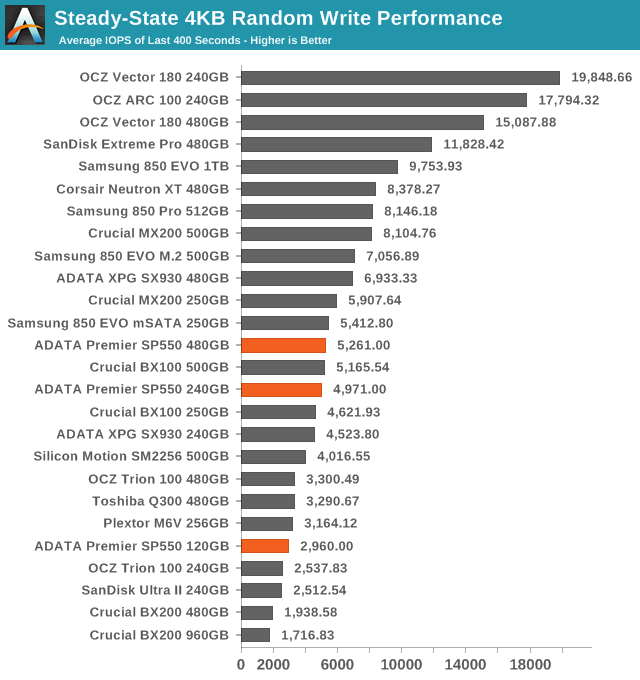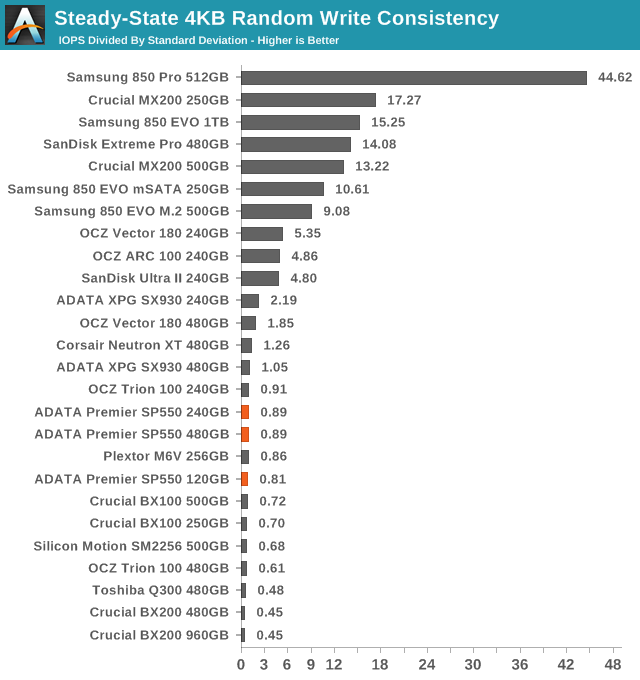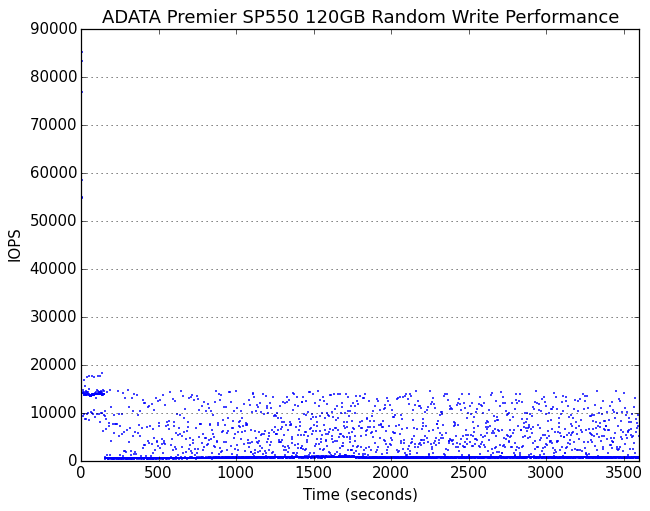The ADATA Premier SP550 SSD Review: A Second Look At Silicon Motion's SM2256 Controller
by Billy Tallis on March 23, 2016 8:30 AM ESTPerformance Consistency
Starting things off, our performance consistency test explores the extent to which a drive can reliably sustain performance during a long-duration random write test. Specifications for consumer drives typically list peak performance numbers only attainable in ideal conditions. The performance in a worst-case scenario can be drastically different as over the course of a long test drives can run out of spare area, have to start performing garbage collection, and sometimes even reach power or thermal limits.
In addition to an overall decline in performance, a long test can show patterns in how performance varies on shorter timescales. Some drives will exhibit very little variance in performance from second to second, while others will show massive drops in performance during each garbage collection cycle but otherwise maintain good performance, and others show constantly wide variance. If a drive periodically slows to hard drive levels of performance, it may feel slow to use even if its overall average performance is very high.
To maximally stress the drive's controller and force it to perform garbage collection and wear leveling, this test conducts 4kB random writes with a queue depth of 32. The drive is filled before the start of the test, and the test duration is one hour. Any spare area will be exhausted early in the test and by the end of the hour even the largest drives with the most overprovisioning will have reached a steady state. We use the last 400 seconds of the test to score the drive both on steady-state average writes per second and on its performance divided by the standard deviation.

For its capacity, the SP550 maintains a higher average random write speed than most low-end drives and even manages to beat some MLC drives, including a narrow advantage over the SM2246EN-based Crucial BX100. This is significant as the only major change between the SM2246EN and the SM2256 was the addition of LDPC error correction, so the firmware on the SP550 is achieving better performance with slower flash on a controller that is basically the same where this benchmark is concerned.

The SM2256 is a budget-oriented controller based around a single-core processor. This makes it extremely difficult to completely eliminate pauses or periods of greatly reduced performance during garbage collection. The SP550 is hardly alone in this, and its consistency scores are typical for its market segment.
 |
|||||||||
| Default | |||||||||
| 25% Over-Provisioning | |||||||||
Upon reaching steady state, the SP550 shows a clear baseline of performance plus some random variation that is capped at the average IOPS attained before the spare area was exhausted. At the higher capacities a much higher share of the writes are completed at full speed and the distribution becomes mostly bimodal.
 |
|||||||||
| Default | |||||||||
| 25% Over-Provisioning | |||||||||
Looking more closely at the steady state, we can see that the garbage collection cycles take longer on the higher capacity drives, though not as long as on the Toshiba Q300. Neither the baseline performance nor the peak performance is strongly dependent on capacity.










25 Comments
View All Comments
zmeul - Wednesday, March 23, 2016 - link
I have the 120GB version and I'm disapointed in it - after just one month it started showing cell voltage drift and on the 2nd month it gotten worse: https://i.imgur.com/l3zonQn.pngnote: it's on a SATA2
A-Data offers no FW update for this drive
hojnikb - Wednesday, March 23, 2016 - link
Thats pretty much what you can expect with any sub 20nm TLC drive.zmeul - Wednesday, March 23, 2016 - link
well, I wish I knew that before I bought itbut neither Anand or any other site does this kind of "over time" testing
Samus - Thursday, March 24, 2016 - link
Basically you've found out first hand: AVOID any TLC drive, even TLC VNAND from Samsung isn't immune to what you are experiencing. At least you only spent $40. I still think the BX100 and OCZ ARC 100 are\were the best value, but they've spiked in price because they are no longer in production and the BX200\Trion 100/150 are a joke. My cheap go to drives now are Sandisk SSD Plus. Super cheap drive, still MLC, and suspect a reliable Marvell controller. Even the Sandisk Z400s is a reliable drive if you can get over the pretty poor performance...at least it isn't TLC performance.The laws of physics are being toyed with using NAND in TLC mode. You can't reliable store 3 values in a binary state. My childish layman's explanation goes like this: With SLC it was simple because if it was "on" it was a 1. With MLC if it was "on" it was a 1 and if it was "off" it was a 1. Using TLC, if its "on" it's a 1 if it's "off" its a 1 and if its "half" it's a 1. LOL
hojnikb - Thursday, March 24, 2016 - link
Actually, vnand tlc is just fine and possibly better than ~15nm MLC.Much larger cells offset the 3 bit per cell disadvantage.
Samus - Thursday, March 24, 2016 - link
I get that it's 40nm, so "leakage" isn't really an issue, but it still suffers from TLC's inherently poor write performance. I still prefer MLC. Especially since, as it stands right now, MLC and TLC drives are virtually the same price. I still pickup old Crucial M500's and Intel SSD320/X25-M's...and occasionally you can find new M500's in retail (Microcenter has the M550 256GB models for $60 right now)Well, they DID. I bought the last 5 at my local store I guess. http://www.microcenter.com/product/453561/256GB_SA...
They have the M500 240GB new for $67.99. Quality Marvell controller, MLC NAND, proven firmware and reliability. Until TLC drives are half that price for the same capacity I don't see what the big deal is.
KAlmquist - Thursday, March 24, 2016 - link
I'm have a hard time believing that 16nm TLC NAND is a good idea. The problems that Samsung has had with data degradation on the 840 EVO suggests that even with 19nm TLC NAND the cell size is too small. While the reviewed drive is priced attractively, I'd be more inclined to buy an MLC drive, or the Samsung EVO 850, which is TLC but with a large cell size.LarsBars - Thursday, March 24, 2016 - link
The MU02 firmware update for the Crucial BX200 resolved the strange ATTO plots that were mentioned in this review. At least for me.jabber - Friday, March 25, 2016 - link
Mmmmm the BX200. The one I got in to test finally bottomed out at a super 40MBps write speed. That was about 6 weeks ago with the latest firmware then. BX200 = Junk. The BX100, now that was and still is a quality drive.bogdan_kr - Saturday, March 26, 2016 - link
@Billy TallisI would like to ask about AnandTech Storage Bench - Light. How long (typically) does it take to finish this bench?
I mean I can see it is designed to read and write about 41GB of data. SP550 480GB finished it with 299.02 MB/s average data rate score so does that mean it took about 140 seconds?